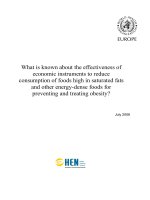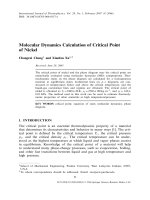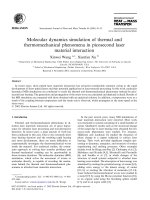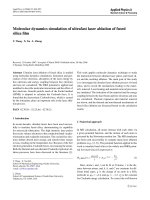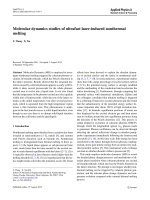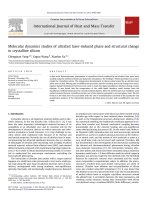Molecular level investigation of interface energy level alignment for organic electronics
Bạn đang xem bản rút gọn của tài liệu. Xem và tải ngay bản đầy đủ của tài liệu tại đây (3.32 MB, 131 trang )
MOLECULAR-LEVEL INVESTIGATION OF
INTERFACE ENERGY LEVEL ALIGNMENT FOR
ORGANIC ELECTRONICS
WANG RUI
(B. Sc, WUHAN UNIV)
A THESIS SUBMITTED
FOR THE DEGREE OF DOCTOR OF PHILOSOPHY
DEPARTMENT OF PHYSICS
NATIONAL UNIVERSITY OF SINGAPORE
(2014)
Declaration
I hereby declare that this thesis is my original work and it has been written by
me in its entirety. I have duly acknowledged all the sources of information
which have been used in the thesis.
This thesis has also not been submitted for any degree in any university
previously.
Wang Rui
15 Aug 2014
To my beloved parents and wife
Acknowledge
My Ph. D study is a wonderful and unforgettable journey in my life, filled
with challenges and excitement. It would have never been possible for me to
write this thesis without the support from many people around me, to only
some of whom it is possible to give particular mention here.
First and foremost, I would like to express my deepest gratitude to my
supervisor Dr. Chen Wei for his support, help and guidance over the past years.
He always offers me precious and selfless help. Because his patient and
encourage, I have overcome the difficulties in research. Without him, I will
never finish my work and thesis.
I am obliged to many group members who helped and supported me.
Thanks to Dr. Chen Zhikuan and Dr. Li Jun who introduce me into the IMRE.
Thanks to Dr. Qi Dongchen, Dr. Mao Hongying, Dr. Huang Yuli, Dr. Huang
Han and Dr. Liu Yiyang for their valuable help and advices on research and
graduate study. Thanks to Dr. Swee Liang Wong, Dr. Niu Tianchao, Dr. Pan
Feng, Dr. Cao Liang, Mr. Tan Mein Jin, Mr. Zhong Jianqiang, Mr. Han Cheng,
Ms. Lin Jiadan, Ms. Zhong Shu, Mr. Xiang Du and all other surface science
lab members, you all are being so nice and sweet!
Most importantly, I am truly thankful to my parents, for raising me up and
for the continuous support and encouragement they have given me all the time.
And also, I offer my earnest thanks to my wife Aki, who has been standing
beside me throughout this period. Without your love, I could never be
succeeded.
List of Publications
1 Scanning Tunneling Microscopy and Photoelectron Spectroscopy
Investigation of the Sexithiophene:C60 Donor-Acceptor Nanostructure
Formation on Graphite
Rui Wang, Hong Ying Mao, Han Huang, Dong Chen Qi, and Wei
Chen, Journal of Applied Physics, 109 (2011), 084307.
2 Tuning of C
60
Energy Levels Using Orientation-Controlled
Phthalocyanine Films
Hong Ying Mao, Rui Wang, Han Huang, Yu Zhan Wang, Xing Yu Gao,
Shi Ning Bao, Andrew Thye Shen Wee, and Wei Chen, Journal of
Applied Physics, 108 (2010), 053706.
3 Mechanism of the Fermi Level Pinning at Organic Donor–Acceptor
Heterojunction Interfaces
Hong Ying Mao, Fabio Bussolotti, Dong-Chen Qi, Rui Wang, Satoshi
Kera, Nobuo Ueno, Andrew Thye Shen Wee, and Wei Chen, Organic
Electronics, 12 (2011), 534-40.
4 Lending Triarylphosphine Oxide to Phenanthroline: A Facile Approach
to High-Performance Organic Small-Molecule Cathode Interfacial
Material for Organic Photovoltaics Utilizing Air-Stable Cathodes
Wan-Yi Tan, Rui Wang, Min Li, Gang Liu,Ping Chen, Xin-Chen Li,
Shun-Mian Lu, Hugh Lu Zhu, Qi-Ming Peng, Xu-Hui Zhu,* Wei
Chen,* Wallace C. H. Choy,* Feng Li,* Junbiao Peng, and Yong Cao ,
Advanced Functional Materials (2014). (in press, contributed equally
as the first author)
5 One Dimensional Molecular Dipole Chain Arrays on Graphite Via
Nanoscale Phase Separation
Yu Li Huang, Rui Wang, Tian Chao Niu, Satoshi Kera, Nobuo Ueno,
Jens Pflaum, Andrew Thye Shen Wee, and Wei Chen, Chemical
Communications, 46 (2010), 9040.
6 Interface Investigation of the Alcohol-/Water-Soluble Conjugated
Polymer PFN as Cathode Interfacial Layer in Organic Solar Cells
Shu Zhong, Rui Wang, Hong Ying Mao, Zhicai He, Hongbin Wu, Wei
Chen, and Yong Cao, Journal of Applied Physics, 114 (2013), 113709.
7 Molecular-Scale Investigation of C
60
∕p-Sexiphenyl Organic
Heterojunction Interface
Jian Qiang Zhong, Han Huang, Hong Ying Mao, Rui Wang, Shu
Zhong, and Wei Chen, The Journal of Chemical Physics, 134 (2011),
154706.
8 Ionization Potential Dependent Air Exposure Effect on the
Moo3/Organic Interface Energy Level Alignment
Jian Qiang Zhong, Hong Ying Mao, Rui Wang, Jia Dan Lin, Yong
Biao Zhao, Jia Lin Zhang, Dong Ge Ma, and Wei Chen, Organic
Electronics, 13 (2012), 2793-800.
9 Effect of Gap States on the Orientation-Dependent Energy Level
Alignment at the Dip/F16cupc Donor–Acceptor Heterojunction
Interfaces
Jian Qiang Zhong, Hong Ying Mao, Rui Wang, Dong Chen Qi, Liang
Cao, Yu Zhan Wang, and Wei Chen, The Journal of Physical
Chemistry C, 115 (2011), 23922-28.
10 Chemical Vapor Deposition Graphene as Structural Template to
Control Interfacial Molecular Orientation of Chloroaluminium
Phthalocyanine
Hong Ying Mao, Rui Wang, Yu Wang, Tian Chao Niu, Jian Qiang
Zhong, Ming Yang Huang, Dong Chen Qi, Kian Ping Loh, Andrew
Thye Shen Wee, and Wei Chen, Applied Physics Letters, 99 (2011),
093301.
11 'Mildly O2 Plasma Treated CVD Graphene as a Promising Platform for
Molecular Sensing',
Hongying Mao, Rui Wang, Jianqiang Zhong, Shu Zhong, and Wei
Chen, Carbon, 76 (2014), 212-19.
12 Room Temperature Ferromagnetism in Partially Hydrogenated
Epitaxial Graphene
Lanfei Xie, Xiao Wang, Jiong Lu, Zhenhua Ni, Zhiqiang Luo,
Hongying Mao, Rui Wang, Yingying Wang, Han Huang, Dongchen
Qi, Rong Liu, Ting Yu, Zexiang Shen, Tom Wu, Haiyang Peng,
Barbaros Özyilmaz, Kianping Loh, Andrew T. S. Wee, Ariando, and
Wei Chen, Applied Physics Letters, 98 (2011), 193113.
13 Electrical Measurement of Non-Destructively P-Type Doped Graphene
Using Molybdenum Trioxide
Lanfei Xie, Xiao Wang, Hongying Mao, Rui Wang, Mianzhi Ding, Yu
Wang, Barbaros Özyilmaz, Kian Ping Loh, Andrew T. S. Wee, Ariando,
and Wei Chen, Applied Physics Letters, 99 (2011), 012112.
14 Surface Transfer Hole Doping of Epitaxial Graphene Using MoO
3
Thin Film
Zhenyu Chen, Iman Santoso, Rui Wang, Lan Fei Xie, Hong Ying Mao,
Han Huang, Yu Zhan Wang, Xing Yu Gao, Zhi Kuan Chen, Dongge
Ma, Andrew Thye Shen Wee, and Wei Chen, Applied Physics Letters,
96 (2010), 213104.
15 CVD Graphene as Interfacial Layer to Engineer the Organic
Donor-Acceptor Heterojunction Interface Properties
Shu Zhong, Jian Qiang Zhong, Hong Ying Mao, Rui Wang, Yu Wang,
Dong Chen Qi, Kian Ping Loh, Andrew Thye Shee Wee, Zhi Kuan
Chen, and Wei Chen, ACS Appl Mater Interfaces, 4 (2012), 3134-40.
i
Table of Contents
List of Tables vi
List of Figures vii
List of Abbreviations xiii
Chapter 1 Introduction 1
1.1 Organic photovoltaic 1
1.1.1 General principle 1
1.1.2 Working principle of OPV 2
1.1.3 Design rules for OPV 5
1.2 Interface nanostructuring of organic-organic heterojunctions (OOHs)9
1.3 Energy level alignment (ELA) at OOH interface 9
1.3.1 Integer charge transfer model 10
1.3.2 Induced density of interface states model 11
1.3.3 Gap state model 13
1.4 Electrode interface modification in OPV 14
1.5 Objective and scope of this thesis 16
Chapter 2 Experimental 18
2.1 Photoemission spectroscopy 18
2.2 Near edge X-ray absorption fine structure 26
2.3 Electronic structures in an organic solid 30
2.4 Scanning tunneling microscopy 32
2.5 Organic molecular beam deposition 37
2.6 Preparation of clean substrates in the UHV chamber 38
2.7 OPV device fabrication 38
Chapter 3 LT-STM and UPS investigation of the C
60
:
ii
sexithiophene organic-organic heterojunction interface
properties 41
3.1 Introduction 41
3.2 STM and PES study of C
60
:6T on HOPG 43
3.2.1 LT-STM study of C
60
:6T on HOPG 43
3.2.2 PES study of C
60
:6T on HOPG 47
3.3 Summary 50
Chapter 4 Tuning C
60
energy levels by orientation
controlled phthalocyanine films 51
4.1 Introduction 51
4.2 UPS study of C
60
on orientation controlled CuPc 52
4.3 UPS study of C
60
on orientation controlled F
16
CuPc 57
4.4 Comparison of the two systems 61
4.5 Summary 63
Chapter 5 Fermi level pinning at organic donor-acceptor
heterojunction interface 65
5.1 Introduction 65
5.2 ELA at CuPc/F
16
CuPc interface 67
5.3 ELA at ZnPc/F
16
CuPc interface 72
5.4 Defects induced gap states model for ELA 74
5.5 Summary 77
Chapter 6 PES and device study at organic/electron
transporting layer interface 79
6.1 Introduction 79
6.2 OPV device property with the ETLs 80
6.3 Energy level alignment of ETLs modified electrode and ETLs/C
60
iii
interface 84
6.3.1 PES study on the ETLs/electrode interface 84
6.3.2 PES study on the ETLs/organic interface 91
6.4 Summary 94
Chapter 7 Thesis summary and outlook 96
7.1 Thesis summary 96
7.2 Future work 99
Reference 101
iv
Summary
Organic solar cell device performance is largely determined by various
interfaces, including the anode/organic or cathode/organic interfaces for
efficient hole or electron extraction, selective hole or electron transport and
exciton blocking, and organic-organic heterojunction (OOH) for exciton
dissociation. This thesis aims to understand the energy level alignment at the
OOH interface and the interface nanostructuring, as well as to develop
effective anode interfacial layer for organic solar cells.
The organic donor-acceptor nanostructure of fullerene (C
60
) and
a-sexithiophene (6T) on graphite are firstly investigated. It is found that the
weak π-π (the van-der-Waals forces) intermolecular interaction between C
60
and 6T plays a key role in the formation of organic nanostructures on graphite.
Room temperature deposition of C
60
on the 6T monolayer on the weakly
interacting graphite substrate results in the coexistence of three energetically
stable structural motifs with a well-defined supramolecular arrangement,
including C
60
zigzag filament, C
60
hexagon and C
60
-pair filament, and hence
the formation of C
60
:6T molecular glass on graphite.
The interface electronic structure of C
60
/ copper (II) phthalocyanine (CuPc)
and C
60
/copper-hexadecafluoro-phthalocyanine (F
16
CuPc) heterojunctions on
SiO
2
and graphite has been studied secondly. Fermi level pinning effect of C
60
molecules on standing CuPc films has been observed. Moreover with the use of
v
orientation-controlled CuPc and F
16
CuPc thin films, the C
60
HOMO energy
levels relative to the substrate Fermi level can be tuned from 1.9 eV for C
60
on
standing CuPc films to 1.0 eV on standing F
16
CuPc films.
We investigate the energy level alignment and the Fermi level pinning
mechanism at the organic donor-acceptor heterojunctions interfaces by using
the model OOHs of the standing CuPc and ZnPc films on the standing F
16
CuPc
thin films on SiO
2
. Through the defect induced gap states, we provide a detailed
explanation for this thickness dependent energy level alignment and Fermi level
pinning mechanism at the organic donor-acceptor OOH interface.
Organic electron transporting layer is critical to improving the power
conversion efficiency (PCE) and long-term stability of an organic photovoltaic
cell that utilizes a low work function anode. In this contribution we report a
novel electron transporting layer (ETL) material with high T
g
and attractive
electron-transport properties. The characterization of photovoltaic devices
involving Ag or Al electrodes shows that this thermally deposited interlayer can
considerably improve the PCE, due largely to a simultaneous increase in V
oc
and
FF relative to the reference devices without an ETL. Ultraviolet photoemission
spectroscopy studies reveal that this promising ETL can significantly lower the
work function of the Ag metal as well as indium tin oxide (ITO) and HOPG,
and facilitate electron extraction in OPV devices.
vi
List of Tables
Table 4.4.1 Summary of work function, HOMO edge, and HOMO peak
maximum of C
60
molecules on standing or lying CuPc and F
16
CuPc thin
films. The error bar is ± 0.05 eV. 61
Table 5.2.1 Summary of sample energetics derived from UPS measurement:
sample WF, the energy position of CuPc HOMO edge and HOMO peak
maximum with respect to the substrate Fermi level, and IP of CuPc top
layers. The errors are within 0.02 eV for all UPS measurement. 68
Table 6.2.1 Summary of the photovoltaic data
(ITO/PEDOT:PSS/P3HT:PC61BM/ETL(x nm)/anode), under light
intensity of 100 mW cm
–2
. Anode = Ag, Al and Ca/Al. The data in
parentheses are the average results of three devices. 82
Table 6.2.2 Summary of the photovoltaic data
(ITO/PEDOT:PSS/PTB7:PC
71
BM/ETL(x nm)/anode), under light
intensity of 100 mW cm
–2
. Anode = Ag, Al and Ca/Al. The data in
parentheses are the average results of three devices. 83
vii
List of Figures
Figure 1.1.1 The schematic of the four step operation principle of a
donor-acceptor OPV. 3
Figure 1.1.2 Typical current-voltage characteristics in an organic solar cell
(dark current, dash curve; light current, full line curve). The important
parameters for the device are illustrated on the axis, while the value of
P
max
is determined by the shadow area. J
m
and V
m
are the current density
and voltage at the maximum power. 4
Figure 1.1.3 Molecular structures of several widely used orgainc donor and
acceptor materials. 6
Figure 1.1.4 Simulated annealing effects on the interface morphology of a
mixed-layer, small-molecule (CuPc, and 3,4,9,10-perylene
tetracarboxylic bis-benzimidazole, PTCBI) bulk heterojunction
photovoltaic cell. a) The initial configuration is generated using a random
number generator, and a mixture composition of 1:1. This also assumes
that no significant phase segregation occurs during deposition at
beginning. The interface between CuPc and PTCBI is shown as a green
surface. CuPc is shown in red and PTCBI is transparent. b–d) The
configurations after annealing are shown for increasing annealing
temperature. (reprinted from Ref. [14] with permission from Nature
Publishing Group, copyright 2003) 7
Figure 1.3.1 Schematic illustration of the evolution of the energy level
alignment when a π-conjugated organic molecule or polymer is
physisorbed on a substrate surface when a) work function Φ
SUB
>E
ICT+
:
Fermi-level pinning to a positive integer charge-transfer state, b)
E
ICT-
<Φ
SUB
< E
ICT+
: vacuum level alignment, and c) Φ
SUB
< E
ICT-
:
Fermi-level pinning to a negative integer charge-transfer state. The
charge-transfer-induced shift in vacuum level, ∆, is shown where
applicable.(reprinted from Ref. [32] with permission from WILEY-VCH
Verlag GmbH, copyright 2009) 11
Figure 1.3.2 Energy level alignment at organic heterojunctions: the initial CNL
difference is partially screened, resulting in the formation of an interface
dipole ∆
OO
and a smaller final CNL offset. (reprinted from Ref. [33] with
permission from Elsevier B.V., copyright 2007) 13
viii
Figure 2.1.1 Illustration of three-step model in photoemission process: (i)
photoexcitation of an electron from an initial state to a final state; (ii)
transport of excited electrons to the surface; (iii) escape from surface to the
vacuum. 20
Figure 2.1.2 (a) A typical experimental set-up for PES measurements. (b) the
energy level alignment between sample and the electron energy analyzer
assuming sample and analyzer are in good electric contact so their Fermi
energies coincide with each other. (from [43] (on-line). Available internet:
) 21
Figure 2.1.3 Schematic diagram of XPS and UPS. The spectra shown on the
right side shows a typical valence band density of states (DOS) and it
corresponding UPS spectrum. 24
Figure 2.1.4 Photograph of PES system, combining an analyzer chamber and a
preparing chamber. The pump system is beneath the stage (not shown). 26
Figure 2.2.1 Schematic diagram of the X-ray absorption transition and the
associated Auger decay channel. The low-energy NEXAFS region with
discrete structure originating from core electron transitions to unoccupied
states (dotted lines shows the deconvolution fittings) and the EXAFS
region with single scattering processes at higher energies, are indicated.
(reprinted from Ref [15] with permission from John Wiley and Sons,
copyright 2011) 28
Figure 2.3.1 Electronic structure presented with potential well (a) Hydrogen
atom, (b) single organic molecule, (c) molecule solid. The position of
HOMO, LUMO, core level, vacuum level, EA, IP and Fermi level is
indicated. 31
Figure 2.3.2 Combined PES and IPES of organic molecule film. The
photoemission onset, core level, HOMO and LUMO edges, Fermi level
(E
F
), vacuum level (E
vac
), IP and EA are indicated. 32
Figure 2.4.1 A schematic picture of STM. (free copyright from Wikipedia
website: 35
Figure 2.4.2 Photograph of LT-STM system, combining an LT-STM chamber
and a preparing chamber. The pump system is beneath the stage (not
shown). 36
ix
Figure 2.7.1 Schematic picture of the organic solar cell. 40
Figure 3.2.1 (a) STM image of 6T monolayer on HOPG, 50×50 nm
2
, V
tip
=-
2.5 V; (b) the corresponding molecularly resolved 7×7 nm
2
STM image,
V
tip
=1.5 V. (c) 150×150 nm
2
STM image for the sample after the RT
deposition of 0.5 ML C
60
on the 6T monolayer, V
tip
=-2.3 V; and (d)
corresponding detailed 20×20 nm
2
STM image, V
tip
=-1.9 V. In panel (d),
the rectangles, circles and elipse highlight the three elementary structural
motifs of the zigzag filament, hexagon and C
60
-pair filament, respectively.
44
Figure 3.2.2 Molecularly resolved STM images for the identified three
elementary structural motifs: (a) the zigzag filament, (b) the hexagon, and
(c) the C
60
-pair filament, and the corresponding schematic models [(d)–(f)]
are attached below each panel. (g) 20×20 nm
2
STM image for the ordered
zigzag C
60
chain arrays on HOPG (V
tip
=-2.2 V) after annealing at 350 K
and its corresponding FFT image is shown in (h) 46
Figure 3.2.3 Thickness dependent synchrotron PES spectra during the
deposition of C
60
on 1 nm 6T on HOPG: (a) valence band spectra at the
low-binding energy part and (b) corresponding close-up spectra near the
E
F
region, (c) PES spectra at the low-kinetic energy part (secondary
electron cut-off), (d) C 1s and (e) S 2p core level spectra. (a)–(c) were
measured with photon energy of 60 eV, and (d) and (e) were measured
with photon energy of 350 eV. All binding energy are relative to the
substrate Fermi level. 48
Figure 4.2.1 He I UPS spectra at the low kinetic energy region (a) and the
low-binding energy region near the Fermi level (b) during the deposition
of C
60
on the standing CuPc film on SiO
2
. (c) plot showing the
vacuum-level, and binding energy shift of HOMO peak maximum, and
plot (d) showing binding energy shift of C 1s, N 1s, Cu 2p core level as a
function of C
60
coverage on 5.0 nm CuPc/SiO
2
. 54
Figure 4.2.2 C 1s (a, c) and N 1s (b, d) core level spectra during the deposition
of C
60
on the standing (a, b) and lying (c, d) CuPc films. 55
Figure 4.2.3 He I UPS spectra at the low kinetic energy region (a) and the
low-binding energy region near the Fermi level (b) during the deposition
of C
60
on the lying CuPc film on HOPG. (c) shows the corresponding plots
of HOMO peak maximum and vacuum-level shift as a function of C
60
coverage. 56
x
Figure 4.3.1 Synchrotron PES spectra at the low kinetic energy region (a) and
the low-binding energy region near the Fermi level (b) during the
deposition of C
60
on the standing F
16
CuPc film on SiO
2
. 59
Figure 4.3.2 Synchrotron PES spectra at the low kinetic energy region (a) and
the low-binding energy region near the Fermi level (b) during the
deposition of C
60
on 10.0 nm standing F
16
CuPc film on SiO
2
. 60
Figure 4.3.3 Synchrotron PES spectra at the low kinetic energy region (a) and
the low-binding energy region near the Fermi level (b) during the
deposition of C
60
on the lying F
16
CuPc film on HOPG. 61
Figure 4.4.1 Low binding energy region of UPS of C
60
films showing the
tuning of C
60
molecular orbital HOMO positions by the
orientation-controlled organic films 62
Figure 4.4.2 Schematic drawings of energy level diagrams at the (a) standing
CuPc/C
60,
(b) lying CuPc/C
60,
(c) standing F
16
CuPc/C
60
, and (d) lying
F
16
CuPc/C
60
interfaces. 63
Figure 5.2.1 Synchrotron-based UPS spectra for the deposition of CuPc on
F
16
CuPc film on SiO
2
at (a, b) the low-binding energy part near the E
F
region (the intensity is on a log scale) and (c) at the low-kinetic energy
region (secondary electron cut-off and the intensity is in linear scale) with
a sample bias of -5 V. (d) Plot shows the trend of the work function,
CuPc HOMO edge and HOMO peak maximum as a function of CuPc
thickness. All spectra are measured with photon energy of 60 eV. All BE
are relative to the Fermi level position of the electron analyzer. 69
Figure 5.2.2 The energy diagram of the CuPc/ F
16
CuPc interface. 71
Figure 5.2.3 (a, b) High-precision and low-background UPS spectra with
monochromatic Xe Iα source (8.437 eV) during the deposition of CuPc
on F
16
CuPc film on SiO
2
at the low-binding energy part near the E
F
region. The intensity in panel (a) is plotted on a log scale to better reveal
the HOMO is reaching the Fermi edge, while panel (b) is plotted in linear
scale. The inset in panel (b) showing the corresponding UPS spectra at
the low-kinetic energy region with a sample bias of -7 V. 72
Figure 5.3.1 UPS spectra during the deposition of 0.1 nm (labeled with (2))
and 0.5 nm (labeled with (3)) ZnPc on F
16
CuPc film (labeled with (1)) on
SiO
2
at (a, b, c) the low-binding energy part near the E
F
region and (d) at
xi
the low-kinetic energy part (secondary electron cut-off and the intensity
is on a linear scale) with sample bias of -7 V. The intensity in panels (a)
and (b) is plotted on a linear scale, while the intensity in panel (c) is
plotted on a log scale to better reveal the HOMO is reaching the Fermi
edge. All spectra are measured with monochromatic Xe Iα source (8.437
eV) 73
Figure 5.4.1 Schematic illustration of the Fermi level pinning mechanism and
the “band-bending” like feature at the CuPc/F
16
CuPc heterojunction
interface 76
Figure 6.1.1 Molecule structure of Phen-NaDPO and NaBDPO. 80
Figure 6.2.1 J–V curves of the photovoltaic devices (a)
ITO/PEDOT:PSS/P3HT:PC61BM/ETL (x nm)/Al, (b)
ITO/PEDOT:PSS/P3HT:PC61BM/ETL (x nm)/Ag. 81
Figure 6.3.1 UPS spectra of ETLs with various thickness deposited on Ag, (a)
and (c) the low kinetic energy region for Phen-NaDPO and NaBDPO, (b)
and (d) the valence band region for Phen-NaDPO and NaBDPO. 85
Figure 6.3.2 UV-vis spectra of Phen-NaDPO and NaBDPO in CH
2
Cl
2
(~ 1.0 ×
10
–5
mol L
–1
) and as films on quartz. 86
Figure 6.3.3 XPS spectra of ETLs with various thickness deposited on Ag, (a)
and (c) P 2p core level of Phen-NaDPO and NaBDPO, (b) and (d) C1s core
level of Phen-NaDPO and NaBDPO. 87
Figure 6.3.4 UPS spectra at the low-kinetic energy part (a), (c) and valence
band spectra near the Fermi level (b), (d) for 10 nm Phen-NaDPO,
NaBDPO on ITO (blue) and HOPG (black) surface. The work function of
pristine substrates is also provided in (a), (c). 89
Figure 6.3.5 XPS spectra of P 2p (a), (c) and C 1s (b), (d) as a function of
thickness for Phen-NaDPO, NaBDPO deposited on HOPG substrates. 90
Figure 6.3.6 Thickness-dependent UPS spectra at the low-kinetic energy part
(a), low binding energy part near the Fermi level (b), the schematic energy
diagram of C
60
on Phen-NaDPO as a function of C
60
thickness (c). 92
Figure 6.3.7 Thickness-dependent UPS spectra at the low-kinetic energy part
(a), low binding energy part near the Fermi level (b), the schematic energy
xii
diagram of C
60
on NaBDPO as a function of C
60
thickness (c). 93
Figure 6.3.8 Schematic of the additional electrical field formed by inserting
ETLs. 94
xiii
List of Abbreviations
6T α-Sexithiophene
6P p-Sexiphenyl
ACA Acridine-9-carboxylic acid
AEY Auger Electron Yield
ARUPS Angular-Resolved Ultraviolet Photoelectron Spectroscopy
BCP Bathocuproine
BE Binding Energy
Bphen 4,7-Diphenyl-1,10-phenanthroline
CuPc Copper Phthalocyanine
DIP Diindenoperylene
DOS Density of States
EA Electron Affinity
ELA Energy Level Alignment
ESCA Electron Spectroscopy for Chemical Analysis
ETL Electron Transporting Layer
EXAFS Extended X-ray Absorption Fine Structure
F
16
CuPc Copper-hexadecafluoro-phthalocyanine
F4-TCNQ Tetrafluro-tetracyanoquinodimethane
FFT Fast Fourier transform
HOMO Highest Occupied Molecular Orbital
xiv
HOPG Highly Ordered Pyrolytic Graphite
HTL Hole Transporting Layer
ICBA Indene-C
60
Bisadduct
ICT Integer Charge Transfer
IDIS Induced Density of Interface States
IETS Inelastic Electron Tunneling Spectroscopy
IP Ionization Potential
IPES Invert Photoemission Spectroscopy
ITO Indium Tin Oxide
KE Kinetic Energy
LDOS Local Density of States
LT-STM Low Temperature Scanning Tunneling Microscopy
LUMO Lowest Unoccupied Molecular Orbital
MoO
3
Molybdenum Oxide
NEXAFS Near Edge X-ray Absorption Fine Structure
NiO Nickel Oxide
NPB 4,4'-Bis(N-phenyl-1-naphthylamino)biphenyl
OFET Organic Field Effect Transistor
OMBD Organic Molecular Beam Deposition
OOH Organic-Organic Heterojunction
OPV Organic Photovoltaic
xv
P3HT Poly(3-Hexylthiophene)
PC
61
BM [6,6]-Phenyl C
61
Butyric acid Methyl ester)
PC
71
BM [6,6]-Phenyl C
71
Butyric acid Methyl ester)
PCPDTBT Poly[2,6-(4,4-bis-(2-ethylhexyl)-4H-cyclopenta[2,1-b;3,4-b0]-dithiophene)-
alt-4,7-(2,1,3-benzothiadiazole)]
PEDOT:PSS Poly(3,4-ethylenedioxythiophene): Polystyrene Sulfonate
PES Photoemission Spectroscopy
PTB7 Poly((4,8-bis[(2-ethylhexyl)oxy]benzo[1,2-b:4,5-b′]dithiophene-2,6-diyl)(3-f
luoro-2-[(2-ethylhexyl)carbonyl]thieno[3,4-b]thiophenediyl))
PV Photovoltaics
QCM Quartz Crystal Microbalance
STM Scanning Tunneling Microscopy
STS Scanning Tunneling Spectroscopy
SubPc Subphthalocyanine
TCTA Tri(N-carbazolyl)triphenylamine
TEY Total Electron Yield
TPD N,N'-(3-methylphenyl)-1,1'-biphenyl-4,4'-diamine
UHV Ultra High Vacuum
UPS Ultraviolet Photoelectron Spectroscopy
UV Ultraviolet
V
2
O
5
Vanadium Oxide
xvi
VL Vacuum Level
WF Work Function
WO
3
Tungsten Oxide
XANES X-ray Absorption Near Edge Spectroscopy
XPS X-ray Photoelectron Spectroscopy
ZnPc Zinc Phthalocyanine
1
Chapter 1 Introduction
1.1 Organic photovoltaic
1.1.1 General principle
With the discovery of photovoltaic effect in silicon p-n junction diode in
1954 by Pearson et. al. from Bell Laboratories, the era of solid state
photovoltaics (PV) has emerged.[1] Due to the rapidly increasing energy
demand and the limited reserve of traditional fossil fuel sources, solar cell
industry as clean and renewable energy sources has grown tremendously in the
last two decades. With the annually 29%-75% growth of global PV installation
since 2005, the PV capacity has reached 139 GW by the end of 2013, and
estimated 35 to 52 GW being installed in 2014. The PV industry is now
increasingly competing with conventional energy sources. However, the high
materials and device production costs hamper their practical use as a main
energy source, i.e. the PV contributes only 0.85% to the electricity demand
now.
In the last decade, intensive research has been devoted to the development
of low cost PV technologies, of which organic photovoltaic (OPV) is one of the
most promising candidates. OPV devices are fabricated by π-conjugated small
molecules (aromatic hydrocarbons) or polymers. The localized states in the

